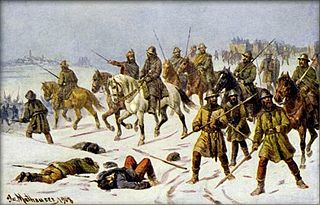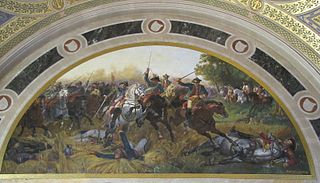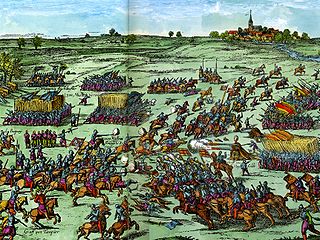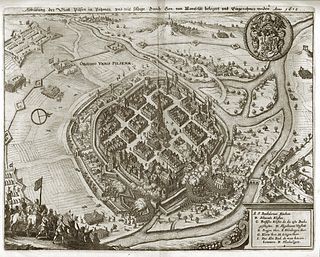 W
WThe Battle of Aussig or Battle of Ústí nad Labem was fought on 16 June 1426, between Roman Catholic crusaders and the Hussites during the Fourth Crusade of the Hussite Wars. It was fought near Aussig in northern Bohemia.
 W
WThe Battle of Chotusitz, or Chotusice, sometimes called the Battle of Czaslau, took place on 17 May 1742, in Bohemia, now the Czech Republic; it was part of the 1740 to 1742 First Silesian War, itself a subsidiary of the wider War of the Austrian Succession.
 W
WThe Battle of Kutná Hora (Kuttenberg), an early battle and subsequent campaign in the Hussite Wars, was fought on 21 December 1421 between German and Hungarian troops of the Holy Roman Empire and the Hussites, an early ecclesiastical reformist group that was founded in what is now the Czech Republic.
 W
WThe Battle of Soor was a battle between Frederick the Great's Prussian army and an Austro-Saxon army led by Prince Charles Alexander of Lorraine during the Second Silesian War. The battle occurred in the vicinity of Soor, also known as Hajnice, in the modern day Czech Republic. The battle started with a failed Austrian surprise attack on the outnumbered Prussians. Despite initial setbacks the Prussian army managed to defeat the Austrians, due to an unexpected attack from a reserve regiment that refused to follow Frederick's orders.
 W
WThe Battle of Sudoměř was fought on 25 March 1420, between Catholic and Hussite forces. The Hussites were led by Břeněk of Švihov - who was killed in battle - and Jan Žižka, whose forces proved victorious. This was the second major battle of the Hussite Wars; the first battle, the Battle of Nekmíř, was more of a Hussite retreat than a true fight.
 W
WThe Battle of Vítkov Hill was a part of the Hussite Wars. The battle pitted the forces of Sigismund, Holy Roman Emperor, against Hussite forces under command of Jan Žižka. Vítkov Hill was located on the edge of the city of Prague and the battle occurred in a vineyard established by Sigismund's father, Charles IV. It ended with a decisive Hussite victory.
 W
WThe Battle of Deutschbrod or Německý Brod took place on 10 January 1422, in Deutschbrod, Bohemia, during the Hussite Wars. Led by Jan Žižka, the Hussites besieged 2,000 Royalist crusaders. The Roman Catholic crusaders were no match for the Hussites and Deutschbrod was quickly taken and sacked. A Royalist arsenal and supply train, numbering some 500 wagons, was captured, one of the largest amounts of loot that the Hussites would take throughout the whole war.
 W
WThe Battle of Domažlice or Battle of Taus or Battle of Tausch was fought on 14 August 1431 as the part of the 5th crusade against Hussites. The crusade was sent to Bohemia after negotiations, held in Pressburg and Cheb, between Hussites and the emperor Sigismund had failed.
 W
WThe Battle of Gitschin or Jičín was a battle of the Austro-Prussian War on 29 June 1866, ending with a Prussian victory over the Austrian forces. There is a memorial there today at Jičín in the Czech Republic.
 W
WThe Battle of Kolín on 18 June 1757 saw 44,000 Austrians under Count von Daun defeat 32,000 Prussians under Frederick the Great during the Third Silesian War. The Prussians lost 14,000 men, while the Austrians lost 8,000 men.
 W
WThe Battle of Königgrätz was the decisive battle of the Austro-Prussian War in which the Kingdom of Prussia defeated the Austrian Empire. It took place near Königgrätz and Sadowa (Sadová) in Bohemia on 3 July 1866.
 W
WThe Battle of Kratzau occurred on 11 November 1428 between an Imperial Silesian army and the Sirotci Hussites in Kratzau, Bohemia. During the battle, the Imperial Silesian army under Hans von Polenz overpowered the Hussite troops. In November 1428, the Hussites under the leadership of Jan Královec launched a campaign from the occupied Kratzau of Friedland and Ostritz to Löbau. The city was not taken by the Hussites, and so they retreated back to Kratzau. Silesian and Lusatia troops pursued the Hussites, defeating them near Kratzau. The loss of vehicles with rations was essential for the Hussites, since supplies were intended for units besieging the Lichnice Castle.
 W
WThe Battle of Kretsch occurred on 19 August 1435 and was the last real battle of the Hussite Wars. A year earlier, the Battle of Lipany brought an end to most Hussite power in Bohemia, but some groups had still continued fighting. Ulrich II von Rosenberg defeated the Taborites near the village of Kretsch, which brought an end to their ability to carry out attacks. After this battle the radical Hussites at Tabor began to make an agreement with Emperor Sigismund.
 W
WThe Battle of Lipany, also called the Battle of Český Brod, was fought at Lipany 40 km east of Prague on 30 May 1434 and virtually ended the Hussite Wars. An army of Moderate Hussite nobility and Catholics, called the Bohemian League, defeated the radical Taborites and Orphans led by Prokop the Great, the overall commander, and by Jan Čapek of Sány, the cavalry commander.
 W
WThe Battle of Lobositz or Lovosice also Lowositz on 1 October 1756 was the opening land battle of the Third Silesian War and the wider Seven Years' War. Frederick the Great's 28,000 Prussians were prevented by 33,000 Austrians under Maximilian Ulysses Count von Browne from continuing their invasion into the rich Bohemian plain, forcing Frederick to ultimately fall back north into Saxony for the winter.
 W
WThe Battle of Münchengrätz or Battle of Mnichovo Hradiště was fought near Mnichovo Hradiště, modern day Czech Republic, on 28 June 1866 during the Austro-Prussian War. It ended in a Prussian victory over the Austrian Empire.
 W
WThe Battle of Náchod on 27 June 1866 was the first major action of the Austro-Prussian War. The advance guard of General Karl Friedrich von Steinmetz's 5th Corps occupied some high ground near Náchod as part of a Prussian advance into Bohemia from Silesia. Elements of the Austrian 6th Corps under General Von Ramming came on the scene and attacked the Prussians but were repulsed. As more Austrians arrived, they were ordered into attacks which proved both costly and unsuccessful. Finally, the badly mauled Austrians retreated from the field. The Prussian infantry enjoyed a technical advantage in having the needle gun, a breech-loading rifle that could be fired and loaded from a prone position. Consequently, the Austrian infantry, which were only equipped with muzzle-loading rifles, suffered a disproportionate number of casualties.
 W
WThe Siege of Pilsen lasted from 14 July 1433 to 9 May 1434 and was an important encounter of the Hussite Wars. Hussite troops led by Prokop the Great had unsuccessfully besieged the Catholic city of Pilsen for nine months and twenty three days. Failure to capture one of the last major Catholic cities in Bohemia along with the fall of New Town was a huge blow for the Hussite groups that foreshadowed their decisive defeat in the Battle of Lipany.
 W
WIn the Battle of Prague or Battle of Štěrboholy, fought on 6 May 1757 during the Third Silesian War, Frederick the Great's 67,000 Prussians forced 60,000 Austrians to retreat, but having lost 14,300 men, decided he was not strong enough to attack Prague. The battle is mentioned in the famous German ballad Lenore written in 1773 by Gottfried August Bürger.
 W
WThe Battle of Reichenberg was a battle of the Third Silesian War, fought on 21 April 1757 near the town of Reichenberg in Bohemia.
 W
WThe Battle of Sablat or Záblatí occurred on 10 June 1619, during the Bohemian period of the Thirty Years' War. The battle was fought between a Roman Catholic Imperial army led by Charles Bonaventure de Longueval, Count of Bucquoy and the Protestant army of Ernst von Mansfeld.
 W
WThe Siege of Pilsen or Battle of Pilsen was a siege of the fortified city of Pilsen in Bohemia carried out by the forces of the Bohemian Protestants led by Ernst von Mansfeld. It was the first major battle of the Thirty Years' War. The Protestant victory and subsequent capture of the city enlarged the Bohemian Revolt.
 W
WThe Battle of Tachov or Battle of Mies was a battle fought on 4 August 1427 near the Bohemian towns of Tachov (Tachau) and Stříbro (Mies). The Hussites won over the armies led by the Cardinal Henry Beaufort of England and Archbishop of Trier Otto von Ziegenhain.
 W
WThe Battle of Trautenau or Battle of Trutnov was fought on 27 June 1866, during the Austro-Prussian War. It was the only battle of the war that ended in an Austrian victory over the Prussians, but at a large cost.
 W
WThe Battle of Vyšehrad was a series of engagements at the start of the Hussite War between Hussite forces and Catholic crusaders sent by Emperor Sigismund. The battle took place at the castle of Vyšehrad from 16 August 1419 to c. 1 November 1420.
 W
WThe Battle of White Mountain was an important battle in the early stages of the Thirty Years' War.